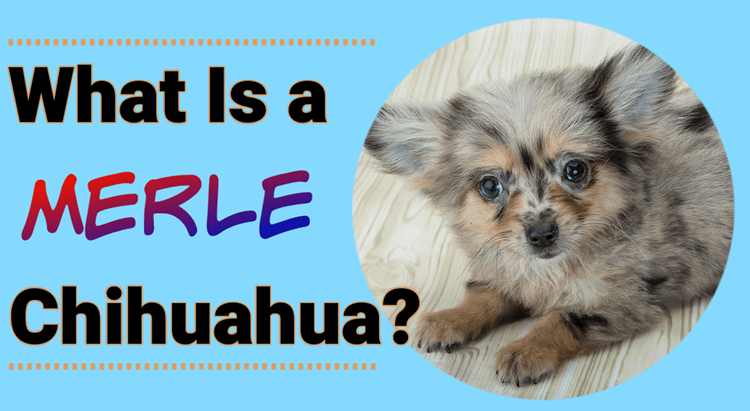
Merle Chihuahuas are adorned for their unique appearance. Some of them have a long coat, whereas others have a smooth coat. All merle Chihuahuas, however, feature a colorful merle coat that distinguishes them from other Chihuahuas, but that’s just the tip of the iceberg regarding their characteristics. What is a merle Chihuahua exactly, and how do they differ from other, non-merle Chihuahuas?
- What Is a Merle Chihuahua?
- Overview of the Merle Gene
- The Breeding of Merle and Non-Merle Chihuahuas
- How the Merle Gene Affects a Chihuahua’s Coat
- How Do Merle Chihuahuas Differ From Other Chihuahuas?
- What Is a Double Merle Chihuahua?
- What Is a Cryptic Merle Chihuahua?
- Are Merle Chihuahuas Allowed to Compete in the Show Ring?
- DNA Testing Kits for Merle Chihuahuas
- In Conclusion
What Is a Merle Chihuahua?
A merle Chihuahua is a Chihuahua with a coat pattern consisting of irregular patches of one or more dark colors on a light-colored base. Known as a merle or dapple pattern, it’s the result of genetics. Chihuahuas, as well as other select breeds (see below), can be born with the merle gene. Chihuahuas born with this genetic abnormality have a merle coat.
Overview of the Merle Gene

Somewhere in the canine kingdom many centuries ago, a mutation occurred that paved the way for the merle pattern. Merle allele (M) is the gene that’s responsible for the merle pattern in Chihuahuas and other breeds. It’s a mutation of the non-merle allele (m) gene.
Alleles are different versions of a given gene. Some genes come in different forms. There’s the merle allele and the non-merle allele, for instance, the former of which is responsible for the merle pattern.
The merle allele is an incompletely dominant gene, whereas the non-merle allele is a recessive gene. As an incompletely dominant gene, the merle allele doesn’t override its recessive counterpart entirely. Both genes will be partially expressed when paired together, with the merle gene being the most predominant.
Like humans, Chihuahuas are born with pairs of genes. They inherit one gene from each parent. All merle Chihuahuas have the Mm genotype. They inherit the merle gene from one parent and the recessive allele from the other parent, resulting in the Mm genotype (except in the case of double merles as explained below).
While working in Dr. Keith Murphy’s Canine Genetics Laboratory at the flagship university in 2006, a team of geneticists and students discovered the merle gene. They found that merle Shelties — the breed studied during the project — had extra DNA tacked onto their PMEL17 or “SILV” gene.
The PMEL17 gene affects pigmentation. When researching merle Shelties, the team identified a SINE insertion involving extra DNA within this pigment-defining gene. The merle Shelties, in other words, had a genetic mutation consisting of the merle gene. Merle Chihuahuas and other merle dogs exhibit this same genetic mutation.
The Breeding of Merle and Non-Merle Chihuahuas
The presence of the merle gene in a sire or dam will determine whether their offspring will be merles. Chihuahua puppies can only be born with the merle gene if at least one of their parents has the merle gene.
- Non-merle x non-merle parents = the entire litter will consist of non-merle Chihuahua puppies.
- Merle x non-merle parents = half of the litter on average will be merles and half will be non-merles.
- Merle x merle parents = half of the litter on average will be merles, one-quarter will be non-merles and one-quarter will be double merles.
How the Merle Gene Affects a Chihuahua’s Coat

The merle gene affects the distribution of pigment within the Chihuahua’s coat. The color or colors of a Chihuahua’s coat is governed by two pigments: eumelanin and phaeomelanin. Eumelanin governs black in a Chihuahua’s coat, and phaeomelanin governs red in a Chihuahua’s coat. Even with just these two pigments, Chihuahuas can have a wide variety of coat colors.
The merle gene specifically affects the distribution of eumelanin, which controls the black color in a Chihuahua’s coat. It essentially dilutes areas of the coat that are pigmented with eumelanin, resulting in irregular patches of dark-colored fur on a light-colored base.
Merle Chihuahuas can further be classified as blue or red depending on the particular shade of their dark-colored fur. Blue merles — the most common type — have patches of black fur. Red merles, in comparison, have patches of brown or copper-colored fur. They are genetically different, but they both have the merle gene.
The Chihuahua isn’t the only breed that can be born with the merle gene. Other breeds include:
- American Bully
- American Pit Bull Terrier
- American Shepherd
- Australian Cattle Dog
- Australian Shepherd
- Beauceron
- Border Collie
- Cardigan Welsh Corgi
- Catahoula Leopard Dog
- Chinese Crested
- Collie (rough and smooth)
- Dachshund (long-haired and wire-haired)
- Dalmatian
- Finnish Lapphund
- Great Dane
- Harlequin Pinscher
- Norwegian Elkhound
- Pomeranian
- Pyrenean Shepherd
- Rat Terrier
- Schipperke
- Shetland Sheepdog
- Shih Tzu
- Silken Windhound
- Whippet
How Do Merle Chihuahuas Differ From Other Chihuahuas?
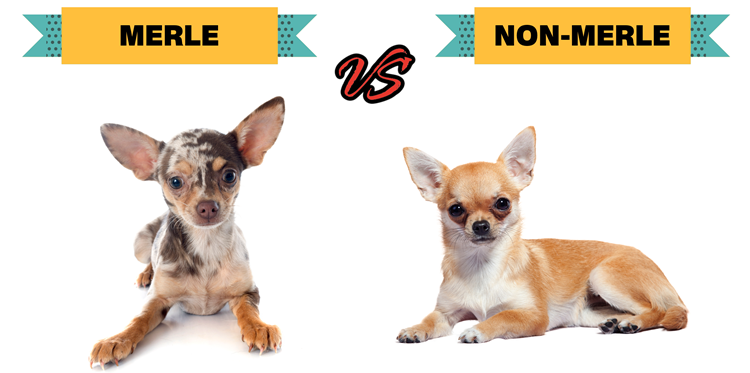
Merle Chihuahuas are easily distinguished from other Chihuahuas by their coat. They feature a unique coat pattern consisting of irregular patches or blotches of dark-colored fur, such as black or brown, on a light-colored base. Aside from their coat pattern, though, merle Chihuahuas differ from non-merles in other ways.
The merle gene can affect the color of a Chihuahua’s eyes and skin. Merle Chihuahuas are more likely to have blue eyes than non-merles. Blue eyes, of course, are common in all newborn Chihuahuas. Non-merle Chihuahuas are often born with blue eyes as well, but their eyes will begin to change to a different, permanent color within the next two to four months. Merle Chihuahuas are often born with blue eyes that don’t change color.
Some merle Chihuahuas have two blue eyes, but others only have a single blue eye. Regardless, blue eyes are a common feature of merle Chihuahuas.
Merle Chihuahuas also commonly have pink mottling on their paw pads and nose. The merle gene affects the distribution of eumelanin throughout the coat, skin and eyes, resulting in these nuances in appearance.
There are certain health problems that are more common in merle Chihuahuas, such as hearing loss. One study found that 4.6% of merle dogs were deaf, with double merles having an even greater rate of deafness. Blindness is another health problem to which merle Chihuahuas are susceptible. Merle Chihuahuas are more likely to suffer from congenital eye defects that impair their vision than non-merles.
What Is a Double Merle Chihuahua?
A double merle Chihuahua is a Chihuahua with the MM genotype. Standard merle Chihuahuas have the Mm genotype in which they inherit the merle gene from one parent and the non-merle allele from the other parent. Double merles inherit a copy of the merle gene from each parent, resulting in the MM genotype.
Double merle Chihuahuas don’t have the same characteristic coat pattern as standard merles. They typically feature smaller and fewer patches of dark-colored fur, and they feature a lighter base color than that of standard merles.
Each copy of the merle gene dilutes the eumelanin in the Chihuahua’s coat. Standard merle Chihuahuas only have a single copy of the gene, but double merles have two copies. With two copies of the merle gene, double merle Chihuahuas have lighter coats. Some double merle Chihuahuas are nearly entirely white except for a few small patches of dark-colored fur.
Double merle Chihuahuas have an even greater risk of health problems than standard merles. The aforementioned study, for example, found that 10% of double merle dogs were unilaterally deaf and 15% were bilaterally deaf.
Common health problems in merle Chihuahuas include:
- Deafness
- Microphthalmia (abnormally small eyes)
- Blindness
-
Canine follicular dysplasia (hair loss)
- Skin cancer
Because of the health problems with which they are associated, breeding double merles is considered unethical. It’s a universally condemned practice — and for good reason. Breeders who intentionally breed double merles expose their puppies to many severe health problems, which can be passed down to future generations. Standard merles have a slightly higher risk of health problems than non-merles, but the risk is substantially higher with double merles.
What Is a Cryptic Merle Chihuahua?
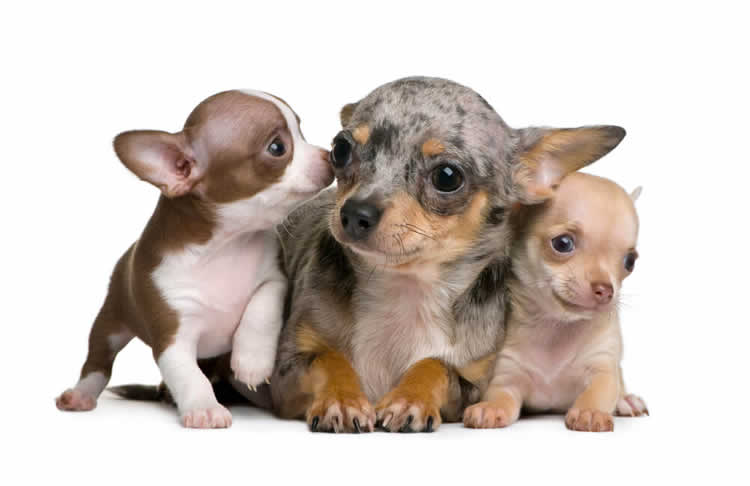
In addition to double merles, there are cryptic merle Chihuahuas. Also known as phantom merles, they have the merle gene but exhibit little or no merle pattern in their coat. Many owners assume they have a non-merle Chihuahua when they actually have a cryptic merle.
Cryptic merle Chihuahuas possess other genetic modifiers that mask the coat-lightening effects of the merle gene. They may have two copies of the recessive red allele, for instance. Chihuahuas with this genotype won’t produce any black fur. The recessive red alleles restrict their coat color to red and shades thereof.
The merle gene only affects areas of the coat that are pigmented with eumelanin. Chihuahuas with two recessive red alleles have phaeomelanin-pigmented coats; they don’t have eumelanin in their coats, so the merle gene doesn’t show up in their coats. Cryptic merle Chihuahuas still have the merle gene, and they may pink blue eyes and pink mottling on their paw pads and nose, but they don’t have the same coat pattern as standard merles.
Are Merle Chihuahuas Allowed to Compete in the Show Ring?
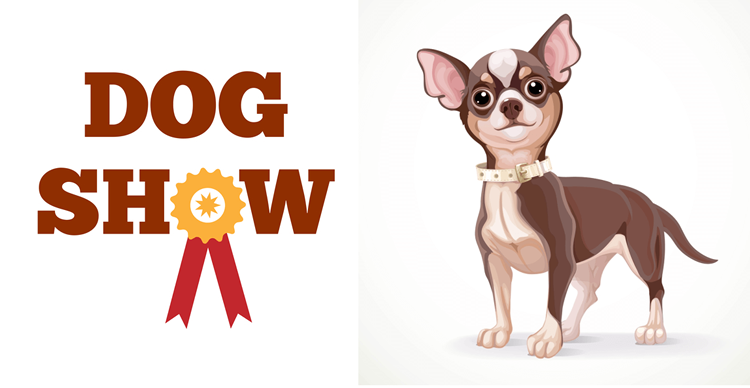
It’s a common misconception that merle Chihuahuas are prohibited from competing in the show ring. Many canine organizations do, in fact, view the merle gene as a fault. They prohibit owners from registering and competing their merle Chihuahuas in the show ring.
In 2007, The Kennel Club (TKC) banned the registration of merle Chihuahuas. Just a few years later, it banned the registration of all Chihuahuas that are the offspring of a merle sire or dam. Even if a Chihuahua doesn’t have a merle coat, it can’t be registered with the United Kingdom’s official canine organization if one or both of his parents are merles. Other non-U.S. canine organizations have implemented their own bans, but the American Kennel Club (AKC) allows merle Chihuahuas to compete in the show ring.
The Chihuahua Club of America (CCA), the AKC’s official parent club of the Chihuahua, voted against the TKC’s disqualification of merle Chihuahuas. The AKC has since added merle as one of the breed’s standard markings. Therefore, you can register your merle Chihuahua with the AKC, and you can compete him in the show ring. The registration requirements for merle Chihuahuas, however, are more stringent than those for non-merles.
DNA Testing Kits for Merle Chihuahuas
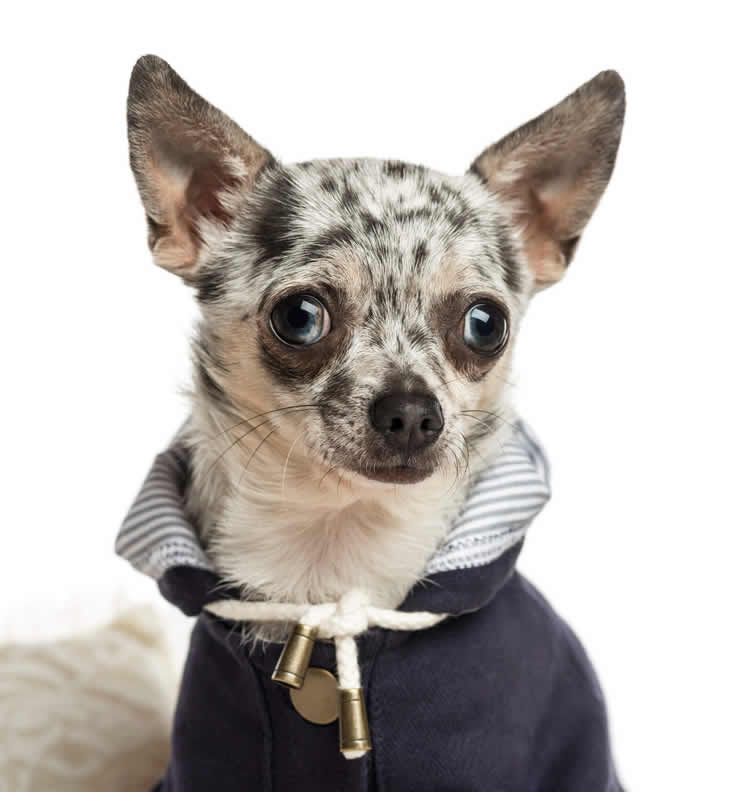
Think your Chihuahua might have the merle gene? You may want to order a DNA testing kit. You can’t rely on appearance alone to determine if your Chihuahua has the merle gene. There are cryptic merle Chihuahuas that look like non-merles. With a DNA testing kit, you can check your Chihuahua’s genotype to determine whether he’s a merle.
Many breeders use DNA testing kits to ensure that they don’t accidentally breed double merles. Breeding a merle sire to a merle dam may result in double merles in the litter. Rather than relying strictly on the appearance of the sire’s and dam’s coats, breeders can use a DNA testing kit. The DNA testing kit will reveal the exact genotype, such as mm, Mm or MM. If the merle gene is present in both the merle and dam, they shouldn’t be bred.
Even if you have no intentions of breeding your Chihuahua, you may still want to use a DNA testing kit. It will provide you with insight into your canine companion’s genetic makeup. You just need to swab your Chihuahua’s mouth for a DNA sample, after which you can mail it to a laboratory for analysis. The company from which you purchased the kit will provide you with a detailed report about your Chihuahua’s genotype.
Here are some of the top DNA testing kits for merles:
In Conclusion
Merle is a genetic pattern found in dozens of dog breeds, one of which is the Chihuahua. It’s characterized by a mottled coat with patches of dark-colored fur on a light-colored base. The merle gene affects the distribution of pigments and can result in a wide range of beautiful coat patterns, including the blue merle patter and the red merle pattern. While merle is not exclusive to Chihuahuas, it adds a distinctive charm to this already captivating breed.
References:
https://www.ncbi.nlm.nih.gov/pmc/articles/PMC1360527/
https://www.ncbi.nlm.nih.gov/pmc/articles/PMC7349775/
https://www.akcchf.org/research/impact-stories/gene-for-merle-color-pattern.html
Do you own a Merle Chihuahua? We’d love to hear what you think about these beautiful small dogs in the comments section below!
I have a white merle. He is so sweet & sassy too! He has 3 patches of black/dark brown on his back. His head and ears are brown, black & brown.
Merle is my favorite coat pattern in chihuahuas. I think merle chihuahuas are beautiful and so unique compared to the breed’s other patterns.
I have a merle but her eyes are green. She’s just a pup, 6 mos old. She’s got long hair and super smart. She’s fit in great with my other chi girls